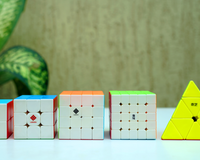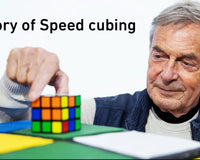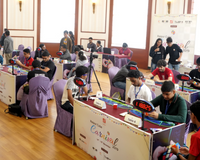Introduction
The Rubik’s cube, being the intimidating puzzle that it is, proves that everything that looks complex isn’t so complex after all. There are a lot of misconceptions about the Rubik’s cube and every cuber has to hear them once in a while. Most misconceptions arise because the solution of the Rubik’s cube is unbeknownst to the majority of people, and as they don’t fully understand the cube, they rely on assumptions and the opinions of other non-cubers. While some of these misconceptions are funny to hear, as a cuber myself, some of the things mentioned in this list are enraging! So let’s discover the misconceptions that non-cubers have about cubing.
If you can solve a Rubik’s cube, you must be good at math
This is one of the most hilarious misconceptions. I’ve heard this so many times from non-cubers and this may be one of the most common misconceptions in this list! People think you need to analyze the cube and do mental math to figure out the solution. 
This is NOT TRUE at all! Rubik’s cube doesn’t require any threshold of IQ to solve it and it is more of a pattern recognition puzzle than a mathematical one. What every cuber does is recognize a case or pattern of colors and execute an algorithm, from a predefined set, to solve that pattern. There is NO calculation involved!
You need to solve one color at a time
Some people assume that a cube is solved one color at a time. Anyone who knows the structure of the puzzle and how it turns knows this is NOT true at all.

A Rubik’s cube is a set of pieces instead of a set of colors. There are 3 kinds of pieces, an edge piece(having 2 colors), a corner piece(having 3 colors), and a centerpiece (having 1 color). All the pieces must be arranged with respect to the fixed center. So, it makes more sense to solve the Rubik’s cube layer by layer, because it is made up of blocks.
There is a “trick” to solve the Rubik’s cube
Most people think of a cuber as a magician and solving the Rubik’s cube as a magic trick. A Rubik’s cube can be solved by just learning the beginners method, which can be learnt by anyone, regardless of IQ or age. I’d love to say that if a Rubik’s cube is a magic trick, then so is building a house and constructing roads! Solving a Rubik’s cube is a methodical process and NOT a magic trick, just like these two examples.
Scrambling longer makes it harder to solve
This is also one of the more common misconceptions about the Rubik’s cube. Any Rubik’s cube, no matter how long or how much it is scrambled, can be solved by the same method in around the same time.

And if you get very technical, every scramble of the Rubik’s cube, no matter how long it’s scrambled, can be solved in under 20 moves. Non-cubers try to separate all the colors to make it the hardest to solve! This might be true to an extent, for example, if the whole cross is solved, it’s obviously easier to solve the whole cube. This is really really rare. Most of the time, extra scrambling is pointless.
It is impossible to solve
This misconception is very rare because most people see the Rubik’s cube being solved at least once in their life. So they know it’s not impossible. But searching on the Internet, you can see that the Rubik’s cube has 43 quintillion possible combinations. So, if you’re not a cuber, it’s really hard to digest that this puzzle can even be solved!
The Rubik’s cube is solved by reversing the scramble
This is the misconception that makes people think that cubers are geniuses and you have to require a lot of IQ to figure out the reverse scramble! And adding to this, if you use fingertricks and turn the pieces really fast, it makes people think that you are a god! Reversing the scramble is really complex and is practically impossible to do. Even if a cuber sees the cube being scrambled, chances are he/she will not even remember the turns that you scrambled the cube with and will resort to solving the cube with the proper method that they learnt.
If you learn how to solve it, the Rubik’s cube becomes uninteresting

Clearing this misconception goes hand in hand with saying that solving a Rubik’s cube is not a magic trick! Most magic tricks seem boring after you learn the trick behind them. So people tend to think that the Rubik’s cube becomes uninteresting after you learn how to solve it. This is NOT true at all. The next challenge after solving a Rubik’s cube is solving it as fast as possible!
You have to figure out the entire solution before starting
This misconception arises because people solve the cube really quickly, so non-cubers think that surely they have planned the solution ahead! They do not notice the small pauses that are taken in between to recognize cases and patterns. Recognition is really very easy and it takes up very less time, which makes people think that there wasn’t any pause.
The Rubik’s cube is a toy
The Rubik’s cube was not designed as a toy. It was designed by Erno Rubik, who was a Hungarian Professor of Architecture. It was reported that the Rubik’s cube was designed as an architectural model for students to understand 3D objects. But in reality, the Rubik’s cube was designed to solve the structural problem of making individual pieces of a 3D model move without the whole structure falling apart. From this information, we can conclude that the Rubik’s cube is NOT a toy. It’s a puzzle that requires patience and focuses to learn how to solve.
You need to be really smart to solve it 
Most people believe that they cannot learn the Rubik’s cube because they don’t have an exceptional IQ or a gifted brain. The Rubik’s cube can be solved by anyone regardless of age or IQ. You just need a good tutorial and a determination to learn how to solve it. It’s really easy to learn, and you don’t have to be a genius.
Conclusion
Hope I cleared up some misconceptions. If you have any person who annoys you with these misconceptions, please share this blog with them! To be honest, personally, I really enjoy these misconceptions because they make non-cubers think of me as some kind of god when I solve it with fingertricks! Jokes apart, picking up the Rubik’s cube is a great hobby and it will clear some of your misconceptions as you understand how the cube is solved.
About Author

Sarthak Masta is a speedcuber from Raipur. He started cubing in 2013 and now has 9 years of cubing experience. Apart from cubing, Sarthak enjoys making music and singing. He has attended a total of 7 competitions in Raipur and has gotten 10 podiums, with 2 gold medals, 4 silver medals and 4 bronze medals.






























